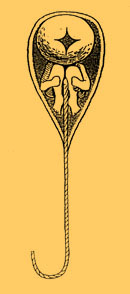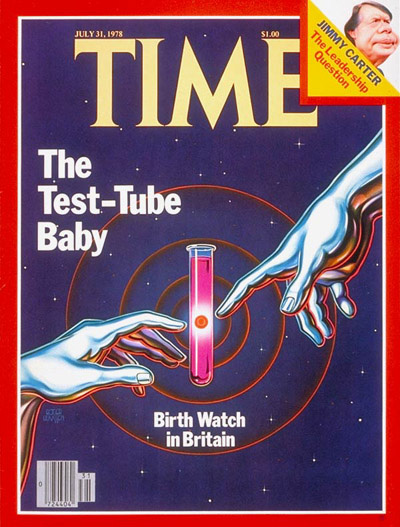
University of California, Irvine
Instructor: Dr. Barbara J. Becker

|
Lecture 20. Finding Tomorrow
|
Human Reproduction
The Hatchery Fertilization
|
||
Bokanovsky's Process
1. 36 hrs after fertilization, embryos given 8 mins exposure to x-rays a few die2. 2 days later, embryos are chilled a few die3. Embryos exposed to near-lethal dose of alcohol a few die4. Embryos finally allowed to develop |
||
Gestation
|
||
Child Development
|
Understanding and Improving Natural Human Reproduction |
Research problems to resolve:
|
| 1677 | Anton von Leeuwenhoek (1632-1723) observed human sperm under a microscope (below, left)
|
 |
||||||||
| 1694 | Homunculus (above, right) drawn by Nicholas Hartsoeker (1656-1725) | |||||||||
| 1784 | Lazzaro Spallanzani (1729-1799) artificially inseminated a dog which gave birth to 3 healthy pups 62 days later. | |||||||||
| 1785 | child born following the first attempts at artificial insemination on a human subject by Scottish surgeon, John Hunter (1728-1793) | |||||||||
| 1827 | Karl Ernst von Baer (1792-1876) identified the mammalian ovum; like many of his predecessors, he regarded sperm cells as parasites; named them "spermatozoa" | |||||||||
"January 1, A.D. 3000" Harper's New Monthly Magazine, vol. 12 (1856) ..."My friend the learned Professor John Pierre Selinghuysen, has invented a plan whereby one portion of the body may be developed to the exclusion of the others. For instance, you bring him a man who is to be a blacksmith. He puts him through a course of treatment which forces all his vital energy into his arms and chest: his legs shrivel up, his head becomes a mere appendage, but his arms and chest are those of a Hercules. Give him a danseuse. In six months her nether extremities will have acquired the strength of iron with the elasticity of India rubber; true, her arms and bust will have dwindled away, but she doesn't need them. For her speciality legs are the thing needful; and therein she is unapproachable. Ah! my good Sir, civilization has made great strides of late years." I acknowledged the fact, and gloomily thought what sort of a world this would be, if we all followed the speciality system, and each person reduced himself to be the mere bearer of a single organ. "Of course you are aware," said he, "that though we have not yet succeeded in finding the proportions of albumen and carbon requisite for the manufacture of a perfect man, we have been very successful with detached members and limbs. It is quite common, nowadays, for a man to have a spare leg or arm at home; and a fellow would be ashamed of wearing the nose nature gave him, if it resembled some of those we see in the old statues."
"Every thing nowadays," continued my guide, "is done in pursuance of a system. We have constantly the best men in the republic at work in search for the best mode of doing whatever has to be done. When they discover that best mode, a law is immediately passed to declare it the only mode, and all others are prohibited under heavy penalties. For instance, in former times the education of children was left to chance and to the caprice of their parents, whence it constantly happened that promising natures were ruined. Now, step in here. This is our Educational Establishment. The day after a child is born he is brought here, and intrusted to the charge of the distributor of infantine nourishment. This is the Infantine Ward, one of the best in the building."
We had entered a large room, on either side of which stood cases such as were used in my time in stores for the reception of goods. Each case was provided with a small mattress and a blanket. Along the front of the cases ran a tube like a gaspipe, and from it shorter tubes, terminating in funnel-shaped mouth-pieces, stretched into each case. The deafening sound which assailed my ear when we entered quite prepared me to discover that almost all the cases were inhabited. A stout man received us with a rough sort of politeness, and in answer to a question from my companion, said that the supply was slack at this season, not over a couple of hundred arrivals per day. I asked where the mothers were. "Mothers? ah! I forgot. I have read of the old-fashioned maternal duties. They must have been a dreadful bore. We did away with them long ago. Children are reared in this establishment from their birth on a substance called supra-lacto-gune. It is composed of 15 parts of gelatin, 25 of gluten, 20 of sugar, and 40 of water, and is certified by the government chemists to be the very best article of nutrition possible. What is the average mortality now, Abdallah?" The stout man said briefly: "Fifty-seven and a quarter per cent." "Think of that!" exclaimed my guide triumphantly; "my friend, Doctor Belphegor, assures me that in former times the mortality among babies was never less than eighty and often a hundred per cent." I said, deferentially, that though the new plan was doubtless far preferable to the old one, the children did not appear to like it, judging from their cries. "Oh! mere play! mere amusement! We like babies to cry. Out of a hundred children who don't cry, we find that exactly eighty-four and three-quarters die under six months; whereas your thorough roarers seldom fail. At fifteen months the babies are removed from this room and pass their examination before the State Phrenological Commission. Their heads are thoroughly examined, their mental capacities recorded, and their vocation in life decided. On leaving the Commissioners' room, each infant has a ticket pasted on its person, bearing the name of the trade or profession to which it is destined. Those who are to be mechanics go through a course of training to prepare them for their apprenticeship, and are then shipped to the country which is appropriate to the industry of which they are to be acolytes. Those, on the contrary, whose phrenological development justifies the Commissioners in setting them apart to be lawyers, doctors, clergymen, or men of letters, are sent to the Grand College of Peerless. This is, we flatter ourselves, the greatest establishment of the kind ever known....
"[B]by a recent special act, parents who are ambitious of early distinction for their children are allowed to send them to private academies on the plan of hot-houses. The youths who are thus reared are placed under cover in a peculiar atmosphere, calculated to hasten the development of the brain. All that the teacher has to do is to keep the thermometer up to a certain point. In this way, children have been produced who calculated eclipses before they could speak, and cut out plans of fortifications in clay before cutting their teeth...."
|
||||||||||
| 1866 | American gynecologist, Marion Sims (1813-1883), performed 55 artificial inseminations on 6 women with cervical abnormalities; one pregnancy occurred | |||||||||
1883
|
Infant could be accessed through door (P). Infant could be viewed through movable glass cover (d). Space (K) filled with sawdust to insulate the cubicle. Heater (Th) raised water (W) temperature. Ventilating air (L) was warmed as it flowed around water reservoir before entering infant cubicle. |
|||||||||
| 1884 | William Pancoast of Philadelphia performed the first confirmed artificial insemination using donor sperm; while under anesthesia, the wife of one of Pancoast's patients was successfully impregnated before an audience of medical students using semen obtained from "the best-looking member of the class" | |||||||||
| 1897 | British biologist Walter Heape (1855-1929) recovered rabbit embryo after flushing oviduct; transferred it to foster-mother, in which normal development continued; work encouraged others to look at possibility of culturing embryos in the laboratory | |||||||||
| 1898 |
Premature infants in mechanical incubators on display |
|||||||||
| 1901 |
Incubators and their premature occupants on display |
|||||||||
| 1904 |
Nurse tending to a premature baby on display |
|||||||||
|
DAEDALUS
A paper read to the Heretics, Cambridge, on February 4, 1923
...It is a fairly safe prophecy that in 50 years light will cost about a fiftieth of its present price, and there will be no more night in our cities. The alternation of day and night is a check on the freedom of human activity which must go the way of other spatial and temporal checks. In the long run I think that all that applied physics can do for us is abolish these checks. It enables us to possess more, travel more, and communicate more. I shall not attempt to predict in detail the future developments of transport and communication. They are only limited by the velocity of light. We are working towards a condition when any two persons on earth will be able to be completely present to one another in not more than 1/24 of a second. We shall never reach it, but that is the limit which we shall approach indefinitely. Developments in this direction are tending to bring mankind more and more together, to render life more and more complex, artificial, and rich in possibilities--to increase indefinitely man's powers for good and evil.... As for the supplies of mechanical power, it is axiomatic that the exhaustion of our coal and oil-fields is a matter of centuries only. As it has often been assumed that their exhaustion would lead to the collapse of industrial civilization, I may perhaps be pardoned if I give some of the reasons which lead me to doubt this proposition. Water-power is not, I think, a probable substitute, on account of its small quantity, seasonal fluctuation, and sporadic distribution. It may perhaps, however, shift the centre of industrial gravity to well-watered mountainous tracts such as the Himalayan foothills, British Columbia, and Armenia. Ultimately we shall have to tap those intermittent but inexhaustible sources of power, the wind and the sunlight. The problem is simply one of storing their energy in a form as convenient as coal or petrol. If a windmill in one's back garden could produce a hundredweight of coal daily (and it can produce its equivalent in energy), our coalmines would be shut down to-morrow. Even to-morrow a cheap, foolproof, and durable storage battery may be invented, which will enable us to transform the intermittent energy of the wind into continuous electric power. Personally, I think that four hundred years hence the power question in England may be solved somewhat as follows: The country will be covered with rows of metallic windmills working electric motors which in their turn supply current at a very high voltage to great electric mains. At suitable distances, there will be great power stations where during windy weather the surplus power will be used for the electrolytic decomposition of water into oxygen and hydrogen. These gasses will be liquefied, and stored in vast vacuum jacketed reservoirs, probably sunk in the ground. If these reservoirs are sufficiently large, the loss of liquid due to leakage inwards of heat will not be great; thus the proportion evaporating daily from a reservoir 100 yards square by 60 feet deep would not be 1/1000 of that lost from a tank measuring two feet each way. In times of calm, the gasses will be recombined in explosion motors working dynamos which produce electrical energy once more, or more probably in oxidation cells. Liquid hydrogen is weight for weight the most efficient known method of storing energy, as it gives about three times as much heat per pound as petrol. On the other hand it is very light, and bulk for bulk has only one third of the efficiency of petrol. This will not, however, detract from its use in aeroplanes, where weight is more important than bulk. These huge reservoirs of liquified gasses will enable wind energy to be stored, so that it can be expended for industry, transportation, heating and lighting, as desired. The initial costs will be very considerable, but the running expenses less than those of our present system. Among its more obvious advantages will be the fact that energy will be as cheap in one part of the country as another, so that industry will be greatly decentralized; and that no smoke or ash will be produced.... The chemical or physical inventor is always a Prometheus. There is no great invention, from fire to flying, which has not been hailed as an insult to some god. But if every physical and chemical invention is a blasphemy, every biological invention is a perversion. There is hardly one which, on first being brought to the notice of an observer from any nation which has not previously heard of their existence, would not appear to him as indecent and unnatural.... ...I am going to suggest a few obvious developments which seem probable in the present state of biological science, without assuming any great new generalizations of the type of Darwinism. I have the very best precedents for introducing a myth at this point, so perhaps I may be excused if I reproduce some extracts from an essay on the influence of biology on history during the 20th century which will (it is hoped) be read by a rather stupid undergraduate member of this university to his supervisor during his first term 150 years hence. "As early as the first decade of the twentieth century we find a conscious attempt at the application of biology to politics in the so-called eugenic movement. A number of earnest persons, having discovered the existence of biology, attempted to apply it in its then very crude condition to the production of a race of super-men, and in certain countries managed to carry a good deal of legislation. They appear to have managed to prevent the transmission of a good deal of syphilis, insanity, and the like, and they certainly succeeded in producing the most violent opposition and hatred amongst the classes whom they somewhat gratuitously regarded as undesirable parents. (There was even a rebellion in Nebraska). However, they undoubtably prepared public opinion for what was to come, and so far served a useful purpose. Far more important was the progress in medicine which practically abolished infectious diseases in those countries which were prepared to tolerate the requisite amount of state interference in private life, and finally, after the [League of Nations'] ordinance of 1958, all over the world; though owing to Hindu opposition, parts of India were still quite unhealthy up to 1980 or so.Our essayist would then perhaps go on to discuss some far more radical advances made about 1990, but I have only quoted his account of the earlier applications of biology. The second appears to me to be neither impossible nor improbable, but it has those features which we saw above to be characteristic of biological inventions. If reproduction is once completely separated from sexual love mankind will be free in an altogether new sense. At present the national character is changing slowly according to quite unknown laws. The problem of politics is to find institutions suitable to it. In the future perhaps it may be possible by selective breeding to change character as quickly as institutions. I can foresee the election placards of 300 years hence, if such quaint political methods survive, which is perhaps improbable, "Vote for Smith and more musicians", "Vote for O'Leary and more girls", or perhaps finally "Vote for Macpherson and a prehensile tail for your great-grandchildren''. We can already alter animal species to an enormous extent, and it seems only a question of time before we shall be able to apply the same principles to our own.... |
| 1932 | Aldous Huxley published Brave New World |
| 1952 |
Amniocentesis allowed fetus to be checked for abnormalities |
| 1955 | Ultrasound introduced in obstetrics |
| 1960 |
Oral contraceptive introduced |
| 1968 | New fertility drugs caused British woman to give birth to sextuplets |
| 1978 |
First 'test tube' baby born |
 |

Louise Brown
By 2012, when Louise Brown reached her 34th birthday, over five million IVF infants had been born worldwide. |
With a little marketing ... traditional reproduction may begin to seem antiquated, if not downright irresponsible. One day, people may view sex as essentially recreational, and conception as something best done in the laboratory.--Gregory Stock |
"...progress is a comfortable disease..." --e.e. cummings (1944)
--Bertrand Russell, Unpopular Essays (1950)
--General Electric slogan (ca. 1965)
--Russell Hoban, Riddley Walker (1980) |
|
|